This guest post by Artemis Linhart appears as part of our theme week on Cult Films and B Movies.
If Heathers (1988) has taught us anything, it’s that “it is one thing to want somebody out of your life, it is another thing to serve them a wake-up cup full of liquid drainer.”
In one of the first and foremost films about the chronic struggle of queen bees versus wannabes, Veronica Sawyer is up against a ruthless trio of Heathers. Led by Heather Chandler, they are the most popular clique in school and, being their newest member, Veronica has already had enough – she longs to return to her “geekish” old friends. The three Heathers can be read to represent the uniformity of the queen bees as well as high school structures in general. As Veronica’s boyfriend J.D. argues, they function in much the same way everywhere: “Seven schools in seven states and the only thing different is my locker combination.” The popular girls seem to be interchangeable templates that, in addition, are the same in every school and, most importantly, every teen movie. But high school as a technicolor battleground has just taken on a new opponent.
Fed up with using her smarts “to decide what color gloss to wear,” Veronica is more self confident and not as obsequious as Heather Chandler’s other minions. Having a strong sense for right and wrong, she is reluctant to accept the regime of an individual adolescent in the social fabric of the school. In order to function as the blatant satire that it is, the film works with an array of cliché characters, yet it offers a remarkable complexity of female characters that transcends the “smart girl in need of a makeover vs. the popular airhead” shtick. Moreover, it blends juvenile delinquency with girlhood without making use of the “outrageous” John Waters style badass girl gang trope.
Channeling both James Dean and Jack Nicholson, J.D. remains the driving force behind the murderous madness. However, there is a certain darkness to Veronica’s character that wavers between desperation and spite and contrasts the teenage girl known from the works of John Hughes and the like. Whereas in the 1970s the cinematic image of (pre-)teen girls was defined by a more demonic form of terror in films like Carrie and The Exorcist, a more subtle kind of horror emerged in the decades to come: the everyday kind. Heathers has paved the way for films like Jawbreaker (1999) and Mean Girls (2004), as well as TV series like Gossip Girl (2007-2012), about a bunch of conniving high school girls with cruel intentions and relentless dress codes. We owe this in part to the Waters brothers, who have found a voice to express the fear and loathing popular high school girls can evoke without demonizing the feminine by its very nature. Incidentally, Daniel Waters (the writer of Heathers) and Mark Waters (director of Mean Girls) have recently teamed up for an upcoming film adaptation of the best-selling teenage fantasy novel Vampire Academy.
Frienemies
The effort of negotiating one’s position in high school’s bizarre pecking order is an anguish many teenagers face. The struggle is real. However, in the case of Veronica, it is not an outsider trying to make his or her way into the popular crowd but an insider trying to get out. “Are you a Heather?” J.D. asks Veronica as they first encounter. “No. I’m a Veronica”; she clearly distinguishes herself from the trio and later on explains, “I don’t really like my friends. It’s just like they’re people I work with and our job is being popular and shit.” Popularity came at a price for Veronica. She had to give up her true friends who, by Heathers-standards, are “the scum of the school.” Heather Chandler runs a tight ship. She considers conversing with the “geek squad” to be “social suicide” and forbids Veronica and her other minion Heathers to do so. Veronica feels oppressed and harbors thoughts of deadly revenge: “Tomorrow I’ll be kissing her aerobicised ass, but for tonight, let me dream of a world without Heather – a world where I am free.”
It becomes clear that, similarly to that of the Mean Girls, the Heathers’ friendship is merely a superficial camaraderie based on phony flattery and a feeling of superiority when it comes to fashion choices. And, of course, power.
Power Dangers
From the very start, J.D. takes control of Veronica and her decisions. She describes their unhealthy relationship in her diary, saying, “I’ve got no control over myself when I’m with J.D.” and concludes with, “Are we going to prom or to hell?”
Upon comprehending that her “teen angst bullshit has a body count,” she declares her “Bonnie and Clyde days” to be over and attempts to break up with J.D. As he explains to Veronica that this will not bring back the dead, she responds, “I am not trying to bring anyone back except maybe myself.” Clearly, she has had enough of being bullied by the Heathers as well as her boyfriend and wants to get back in touch with her true self. Moreover, Veronica is well aware of how the mean girl torch is merely being continuously passed on to the next queen bee. In a dream she realizes with distress that “tomorrow someone else is just gonna move into her place,” and, in a worried tone, adds, “That person could be me!”
Within the Heathers, it is Heather Chandler who’s boss. Just like hoop earrings are “Regina’s thing” in Mean Girls, wearing the color red is Heather Chandler’s thing. After her death, the next Heather takes her place and genuinely revels in wearing red. The red scrunchie that we see in the very first shot of the film is passed on from one queen bee to the next and when asked why she is “such a mega bitch,” the new head of the Heathers replies, “Because I can be.”
But as J.D. blackmails her, she goes from controller to controllee and it is once again him who is in charge. The film’s title song, “Que Sera,” stands in great contrast to J.D.’s urge to manipulate those around him and, essentially, “play god.” Eventually, he explains his plans to blow up the entire school by disputing the underlying problems within society itself, his argument being: “The only place different social types can genuinely get along is in heaven.” Basking in his outburst of mansplaining, J.D unmasks high school as a type of societal microcosm and blames it for his own issues as well as structural complications and hierarchies.
Indeed, the social structure of Westerburg High School is unsettling to say the least. Teens there would rather commit actual suicide than “social suicide.” Their alienation from both reality and ethical values is mirrored not only in J.D., Veronica and the Heathers, but also in the rest of the students. Peer pressure and the dream of popularity result in the “Westerburg suicides,” causing a downright suicide craze. Their supposed actions gave the popular kids depth and humanity and made them more popular than ever. When an unpopular girl attempts to kill herself, the new Heather in charge asserts, “Just another case of a geek trying to imitate the popular people of the school and failing miserably.”
In the end, we get a happy ending of the macabre kind. J.D. loses to Veronica’s bravery as she stands up to him and saves the school from a deathly massacre. It is a victory of fairness, feminism, and friendship. Veronica is the new queen bee. While it becomes clear that, on the whole, high school will remain a place dominated by “the cool crowd,” at least Veronica’s authority might allow for a more humane form of leadership.
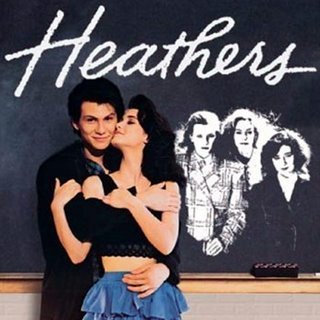
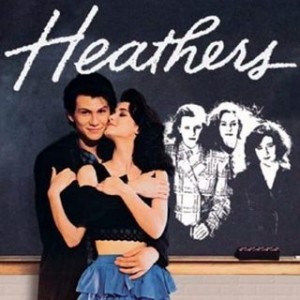
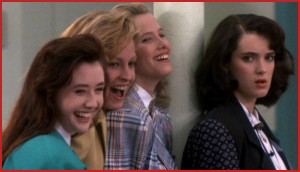
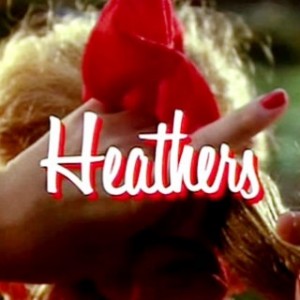
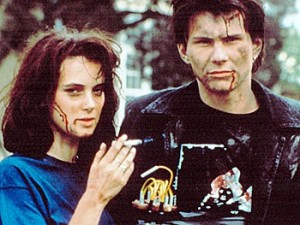
5 thoughts on “Veronica Decides Not To Die – ‘Heathers’: The Proto-‘Mean Girls’”
Comments are closed.